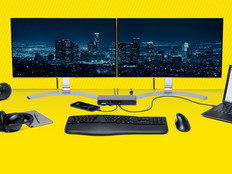Small but Strong
Desktop virtualization appeals to IT because it reduces support and maintenance costs. An important component to any desktop virtualization deployment is the device that sits on each user’s desk: the thin client. Wyse Technology’s V10L thin client provides flexibility, power and manageability at an affordable price.
Advantages
The Wyse V10L thin client sports a small footprint, measuring just 1.8 inches wide by 7.1 inches deep and 7.9 inches tall. And because there’s no spinning hard drive or cooling fan, the device operates quietly.
The V10L can incorporate Wyse’s TCX extensions for USB support and enhanced multimedia. One of the biggest stumbling blocks in creating a virtual desktop infrastructure (VDI) is the ability to play audio and video files smoothly. Media playback is resource-intensive, and server-based computing relies heavily on the thin client’s ability to update display changes quickly. During the V10L test drive, we watched parts of “Terminator 3,” and the playback looks and feels just like a traditional desktop system.
The V10L, with its 800-megahertz Eden processor, also solves a common user complaint: boot time. It boots up in seconds.
Why It Works for IT
There are a number of reasons for IT to embrace the Wyse V10L. First off, there are no moving parts. It’s possible for a thin client such as the Wyse V10L to last 10 years without significant performance degradation. Try getting that out of a standard PC.
When there’s a problem with the hardware, you swap it out for another Wyse V10L, and the user is back up and running immediately. There’s very little configuration, and no need to copy over a user’s data or profile because that resides on the server in the data center; just pull out the old hardware and plug in the new. The Wyse V10L also supports a number of VDI configurations, making it a flexible choice.
Wyse V10L thin clients are all centrally managed with the use of simple .ini configurations. Using a combination of the File Transfer Protocol and Dynamic Host Configuration Protocol, rapid updates and upgrades can be pushed to the devices.
The V10L also offers energy efficiency, using 17.2 watts when connected to a monitor, keyboard and PS/2 mouse, whereas a typical desktop averages about 125W.
Disadvantages
Although the Wyse V10L provides many of good features one seeks, there are still a few things to keep in mind. The peripheral device support for such things as CD-ROM drives or USB storage is limited out of the box. It’s a smart idea to buy the optional Wyse TCX Multimedia program to allow for USB support and for the multimedia enhancements.
Even with TCX, multimedia support is still a work in progress. For example, Adobe Flash applications perform somewhat poorly on the V10L. Not all environments have a need for Flash support, but check to make sure any multimedia applications your agencies uses are compatible.
Finally, you need to prepare your users; some will have a hard time adjusting to the loss of local storage. Evaluate your culture (or cultures) and consider pilot rollouts with test groups to gauge user acceptance before diving headfirst into your VDI deployment.







